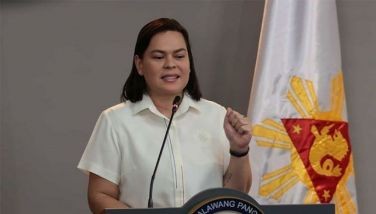Yearender: A pivotal phase for Philippine agriculture

MANILA, Philippines — A year and a half into the Marcos administration, the Philippine agriculture sector is still on a tightrope in terms of balancing local food production and importation of key commodities.
With high input and retail costs coupled with the potential impact of El Niño, this balancing act seems like a tall order for President Marcos’ full-time successor, Agriculture Secretary Francisco Tiu Laurel, who was appointed last Nov. 3.
Marcos described Laurel as someone who has a “fair understanding” of “what needs to be done.”
Before his appointment to the Cabinet, he served as president of Frabelle Fishing Corp. – the world’s third largest tuna fishing company – from 1985 to Oct. 31 this year. His wealth of experience spans diverse industries, encompassing fishing, meat and seafood processing, cold-chain networks and aquaculture as well as shipbuilding and repair, all of which he now brings to the DA.
With his extensive experience, some within the agriculture and fisheries sector are hopeful that Laurel will prioritize local production over resorting to importation to ensure the country’s food security and affordability.
While some express support, others are eager to see the new agriculture chief demonstrate his worth and expertise beyond being one of the biggest campaign donors to President Marcos during his 2022 presidential campaign.
Laurel was encouraged to reconsider liberalization policies that led to an influx of imported goods, emphasizing the need to uplift the morale and productivity of local food producers.
But barely a month since his appointment, the National Economic and Development Authority (NEDA) Board endorsed the extension of lower tariffs on key commodities, such as rice, corn and pork, under Executive Order (EO) 10. President Marcos has approved the extension for another year.
The NEDA endorsement aims to avoid the return of tariff rates to 30 percent in-quota and 40 percent out-quota for pork, to 40 percent in-quota and 50 percent out-quota for rice, and to 35 percent in-quota for corn by Jan. 1.
Presently, importers benefit from a 15 percent in-quota and 25 percent out-quota tariff rate for pork, a reduced tariff of 35 percent on imported rice, and a five percent in-quota tariff on corn until Dec. 31.
While importers are pleased with the prospect of an extended low tariff regime, local producers argue that they are on the losing end, as this endorsement would only further encourage the importation of rice, corn and pork.
“Despite our submission of hard data that demonstrate EO 10 did not significantly reduce retail prices of pork and rice, the economic managers remained steadfast in their ‘import more’ policy. President Marcos was likely misled with false or selective information and advice. The real winners are a few importers and traders,” Federation of Free Farmers (FFF) national manager Raul Montemayor said.
Last year, the Philippines once again overtook China as the world’s top rice importer, according to the United States Department of Agriculture (USDA). The Philippines had held the top spot in 2008, 2010 and again in 2019.
The USDA forecasts the Philippines to import 3.8 million metric tons (MT) of rice in the marketing year 2023-2024 (or from August 2023 to July 2024 in the US agency’s calendar).
Last year, the country shipped a record high 3.83 million MT of rice. As of Dec. 14, Philippine rice imports had already reached 3.22 million MT.
The DA anticipates a decrease in rice imports for the current year compared to the record high in the previous year, with production expected to reach another record performance of 20 million MT. The highest palay production on record was attained in 2021, reaching an output of 19.96 million metric tons.
Despite the massive importation of rice, retail prices of the staple continued to soar in public markets.
This led President Marcos, who was the agriculture chief at the time, to issue Executive Order 39 in September, imposing price caps of P41 per kilo for regular milled rice and P45 per kilo for well-milled rice.
The price caps, which were issued following the reported widespread illegal trade manipulation despite the staple food’s ample supply, were lifted in early October.
But based on the DA’s monitoring as of Dec. 21, the retail price of local regular milled rice still ranged between P38 and P52 per kilo; local well-milled rice, between P32 and P56 per kilo; local premium rice, between P50 and P62 per kilo; and local special rice, between P54 and P68 per kilo.
The retail price of imported well-milled rice is P58 per kilo; imported premium rice, between P51 and P60 per kilo; and imported special rice, between P58 and P65 per kilo.
This is still a long way from the P20 per kilo campaign promise of President Marcos due to the uncertainties in the world market. But this price point remains the aspiration of the Marcos administration, Laurel said.
Meanwhile, the same case can be said with the local pork industry – retail prices have remained high while local producers struggled to match the price of low-priced imported pork, thereby affecting their productivity.
The pork industry, which is still on the recovery path from the harsh impact of the African swine fever since 2019, said the continued implementation of the reduced tariff did not translate to cheaper pork to consumers and further extending this would only result in uneven retail pricing of pork in the markets and discourage hog raisers.
“The local hog industry is disappointed with the recent extension of EO 10 until the end of 2024. Importation at reduced tariff for pork has always been the lazy solution of NEDA for almost four years now and it means another year of suffering for local producers. We are with the government to tame down inflation, but they should also make tangible efforts on improving local production,” Pork Producers Federation of the Philippines Inc. (ProPork) president Rolando Tambago said.
With a lot more problems faced by the agri-fishery sector, Laurel said “feeding 118 million Filipinos is a daunting yet ‘achievable goal’ with a whole-of-nation approach to the modernization of the long-neglected agriculture sector.”
Laurel said the DA would step up efforts to mechanize farming, build more agricultural infrastructure and adopt latest technologies to boost the country’s food production and eventually address the importation issue.
As per President Marcos’ directive, the push for agricultural modernization will focus on equally important sectors like rice, livestock, poultry, fisheries and high value crops to ensure that affordable food items are readily available and accessible to Filipino consumers.
- Latest
- Trending































